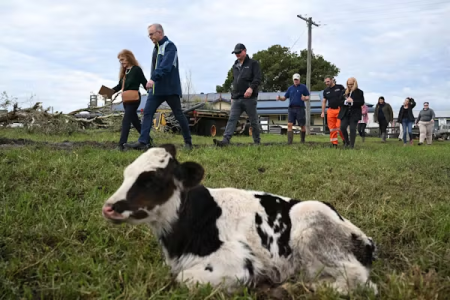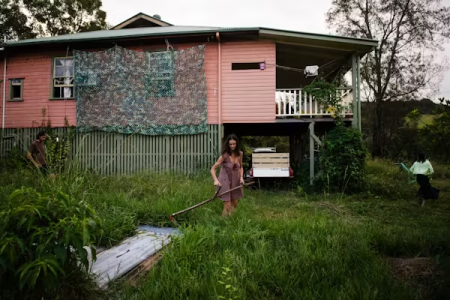NSW is again cleaning up after major floods. Are we veering towards the collapse of insurability?
- Replies 6
Once again, large parts of New South Wales have been devastated by floods. It’s estimated 10,000 homes and businesses may have been damaged or destroyed and the Insurance Council of Australia reports more than 6,000 insurance claims have been received for the Mid North Coast and Hunter region.
Hundreds of families are displaced. With many homes now uninhabitable, they face a uncertain future.
As the mop-up begins, stories are emerging of households and businesses not covered by insurance, with some residents saying insurance companies were asking up to A$30,000 annually for cover.
There are many others who are underinsured, with insurance payouts not meeting the full costs of rebuild, repair and replacement. The Insurance Council of Australia has declared the event an “insurance catastrophe”.
The impacts of these floods reflect global trends. In 2024, there were around 60 natural disaster events that each exceeded A$1.5 billion in economic losses. Total losses worldwide reached A$650 billion.
As one of the most disaster-prone countries in the Western world, is Australia the canary in the coalmine for a global collapse of insurance? With these types of disasters escalating in a changing climate, it is reasonable to feel – and fear – this is the case.
An uninsurable future?
In 1992, sociologist Ulrich Beck argued unpredictable global risks, such as climate change, would bring an end to the private insurance market, with profound effects on the modern world.
The idea of an uninsurable future stirs up imaginings of apocalyptic landscapes – crumbling buildings, streets strewn with refuse and people eking out a living amid the rubble and ruins.
But the reality is, as we are seeing in central NSW, it is not a future event that demands attention. Many individuals and communities are already living with an unfolding collapse of insurance affordability and availability.
The consequences can be dire, especially for those already struggling to make ends meet.

How are governments responding?
Speaking on ABC radio on Thursday morning, NSW Premier Chris Minns said he would be “putting the heat” on insurance companies:
In the lead-up to the federal election, both major parties made clear they believed insurers were “ripping off” Australians. The Coalition even proposed new emergency divestiture powers that would allow the government to break up major insurers in the case of market failure.
But this is no solution at all, given insurance pricing and coverage is largely set by global “reinsurers”. Reinsurance is a kind of insurance coverage for insurance companies themselves – that is, policies to cover the cost of paying out claims after major disasters.
Just ten multi-billion dollar companies control 70% of the reinsurance market.
Who should bear rising costs?
Insurers, led by the Insurance Council of Australia, are pushing for a Flood Defence Fund and retrofitting homes for disaster resilience, paid for by governments and households.
These ideas might seem logical. But they draw attention away from a thriving industry and regulations and policies aimed at making insurance more affordable and effective for ordinary people.
In places like Australia, the increasing cost of insurance cuts across all types, with the largest rises coming in home, vehicle, and employers’ liability insurance.
Many insurers are reporting healthy profits. Globally, the sector is experiencing “exceptionally strong growth”.
Over the three years to 2024, revenue from premiums in the insurance sector increased by over 21% globally – a “whopping” rise, according to the finance corporation Allianz.
Where to from here?
The insurance sector will continue to grow – and profit – until it no longer can due to climate change and other pressures.
But it is not a future crash of insurers that should be of primary concern. It is the real-time collapse of insurance for households, businesses and communities.
As this collapse of insurance unfolds, it is largely left to households and communities to take action and build resilience.
Examples include squatters taking possession of flood-damaged vacant homes in Lismore and, when combined with the housing crisis, the growth in informal housing and settlements on the fringes of major population centres.
These are desperate responses. But they are also realistic, given governments and insurers are failing to reverse this trending collapse.
What else we could do
After each major disaster event comes a rise in insurance costs and a withdrawal of insurance coverage. To avoid being a canary in the coalmine, Australia urgently needs government intervention in the insurance industry - an industry very resistant to such intervention.
To ensure everyone is adequately covered when disaster strikes, this could come in the form of an equitable and affordable public insurance scheme.
As more Australians lose the ability to insure themselves, governments must also address growing structural inequality that is undermining social cohesion and our capacity for collective resilience.
This article is republished from The Conversation under a Creative Commons license. Read the original article.
Hundreds of families are displaced. With many homes now uninhabitable, they face a uncertain future.
As the mop-up begins, stories are emerging of households and businesses not covered by insurance, with some residents saying insurance companies were asking up to A$30,000 annually for cover.
There are many others who are underinsured, with insurance payouts not meeting the full costs of rebuild, repair and replacement. The Insurance Council of Australia has declared the event an “insurance catastrophe”.
The impacts of these floods reflect global trends. In 2024, there were around 60 natural disaster events that each exceeded A$1.5 billion in economic losses. Total losses worldwide reached A$650 billion.
As one of the most disaster-prone countries in the Western world, is Australia the canary in the coalmine for a global collapse of insurance? With these types of disasters escalating in a changing climate, it is reasonable to feel – and fear – this is the case.
An uninsurable future?
In 1992, sociologist Ulrich Beck argued unpredictable global risks, such as climate change, would bring an end to the private insurance market, with profound effects on the modern world.
The idea of an uninsurable future stirs up imaginings of apocalyptic landscapes – crumbling buildings, streets strewn with refuse and people eking out a living amid the rubble and ruins.
But the reality is, as we are seeing in central NSW, it is not a future event that demands attention. Many individuals and communities are already living with an unfolding collapse of insurance affordability and availability.
The consequences can be dire, especially for those already struggling to make ends meet.

On Tuesday, Prime Minister Anthony Albanese visited flood-affected areas in Taree, NSW. Dean Lewins/AAP
How are governments responding?
Speaking on ABC radio on Thursday morning, NSW Premier Chris Minns said he would be “putting the heat” on insurance companies:
In the lead-up to the federal election, both major parties made clear they believed insurers were “ripping off” Australians. The Coalition even proposed new emergency divestiture powers that would allow the government to break up major insurers in the case of market failure.
But this is no solution at all, given insurance pricing and coverage is largely set by global “reinsurers”. Reinsurance is a kind of insurance coverage for insurance companies themselves – that is, policies to cover the cost of paying out claims after major disasters.
Just ten multi-billion dollar companies control 70% of the reinsurance market.
Who should bear rising costs?
Insurers, led by the Insurance Council of Australia, are pushing for a Flood Defence Fund and retrofitting homes for disaster resilience, paid for by governments and households.
These ideas might seem logical. But they draw attention away from a thriving industry and regulations and policies aimed at making insurance more affordable and effective for ordinary people.
In places like Australia, the increasing cost of insurance cuts across all types, with the largest rises coming in home, vehicle, and employers’ liability insurance.
Many insurers are reporting healthy profits. Globally, the sector is experiencing “exceptionally strong growth”.
Over the three years to 2024, revenue from premiums in the insurance sector increased by over 21% globally – a “whopping” rise, according to the finance corporation Allianz.
Where to from here?
The insurance sector will continue to grow – and profit – until it no longer can due to climate change and other pressures.
But it is not a future crash of insurers that should be of primary concern. It is the real-time collapse of insurance for households, businesses and communities.
As this collapse of insurance unfolds, it is largely left to households and communities to take action and build resilience.
Examples include squatters taking possession of flood-damaged vacant homes in Lismore and, when combined with the housing crisis, the growth in informal housing and settlements on the fringes of major population centres.
These are desperate responses. But they are also realistic, given governments and insurers are failing to reverse this trending collapse.
What else we could do
After each major disaster event comes a rise in insurance costs and a withdrawal of insurance coverage. To avoid being a canary in the coalmine, Australia urgently needs government intervention in the insurance industry - an industry very resistant to such intervention.
To ensure everyone is adequately covered when disaster strikes, this could come in the form of an equitable and affordable public insurance scheme.
As more Australians lose the ability to insure themselves, governments must also address growing structural inequality that is undermining social cohesion and our capacity for collective resilience.
This article is republished from The Conversation under a Creative Commons license. Read the original article.








